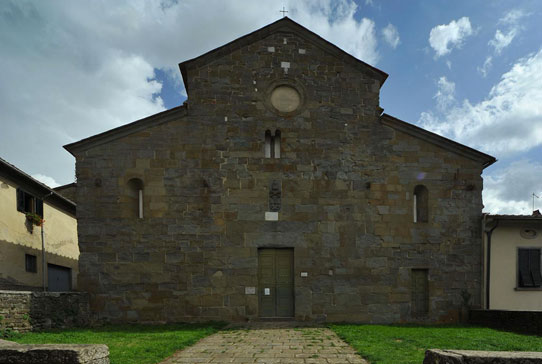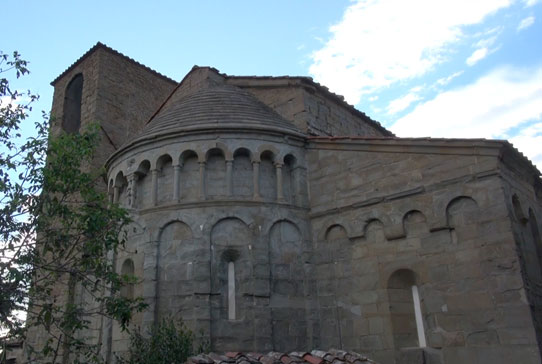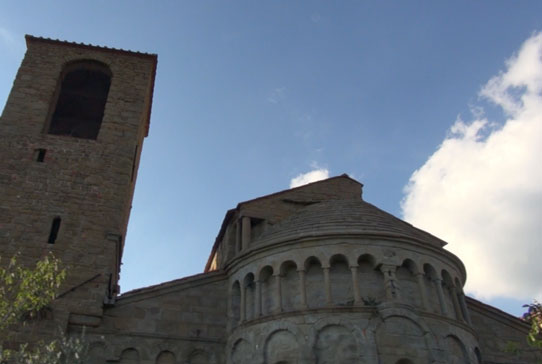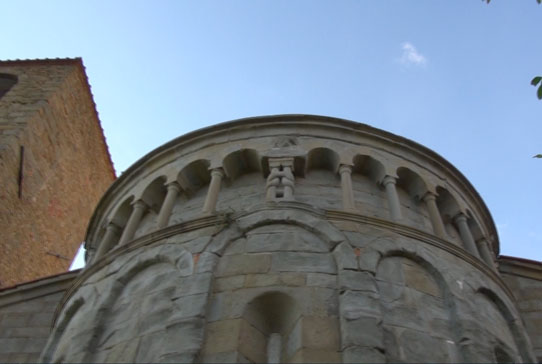THE FAÇADE AND THE EXTERIOR
The façade of the pieve of Gropina in its present state is in simple blocks of smooth sandstone, and gives an idea of the three naves inside, the central one being higher than either side. To the right of the main portal there is an entrance to the right nave, and two single-lancet windows provide light inside. A graceful biphora surmounted by a large round window is above. The monophoras appear to be restored, but they were certainly part of the original design. It is a severe façade, similar to that of other Romanesque churches in the Valdarno, and later additions do not detract from its sobriety. The date 1422 is carved on the architrave of the principal portal (probably referring to uninvasive restorations to be explained when speaking about the capitals), separated by a blazon with a cherub: stylistically both the shield and the angel are later than the inscription, and they might date from the first quarter of the 16th century, perhaps when the pieve, in 1515, according to the wishes of Leo X, passed to the Chapter of Santa Maria del Fiore, the symbol of which was in fact a seraph. Above the architrave, between the two monophoras, stands the coat-of-arms of that Pope, surmounted by the keys of St. Peter and by the papal tiara. The elegant shield bears the Medici insignia, without, however, the lily of France, granted by Louis XI in 1465 to Piero di Cosimo de' Medici (the Gouty) and his heirs and successors. The year carved below is 1522, but the emblem now visible is a 19th-century reconstruction (over the keys appears the date 1875), certainly because the original one must have been in poor condition due to erosion of the stone; the mentality of that period often called for reproducing ex novo a work of art in a precarious state of conservation, rather than trying to preserve it.
The large oculus above the biphora (restored and reopened during the 20th-century restorations) that gives light to the central nave also dates from the 16th century. It is surmounted by a man’s head in marble which legend identified as a portrait of Matilde of Canossa, but which actually must have been part of a possibly funereal group of the Roman period taken from lower down in the valley, probably from along the Cassia Vetus. Heads in full relief on church façades are found elsewhere, such as in the large lunette of the principal portal of the pieve of San Casciano a Settimo (Pisa), from the 12th century, with an architrave sculpted by Biduino in 1180: there the head is of a bearded man. A peculiarity of the façade is that the portal and biphora are not aligned with the apex of the roof, although the oculus, inserted later, is perfectly in line: this was due to an error of calculation and planning, as will be seen when discussing the interior, and in the transformation of the Lombard church into the Romanesque, with the intention of enabling the faithful to continue to participate in religious functions.
One of the most beautiful features of the pieve of Gropina is its apse: in the style of Pisa and Lucca, as Mario Salmi (1971) was the first to notice, its exterior is decorated by a series of blind arches separated by pilasters and surmounted by a small elegant gallery with horse-shoe arches, supported by twelve small columns centrally separated by a pair of intertwined (ophidian) columns (now restored) similar to those supporting the pulpit. In 1912 Mario Salmi had attributed the apse to skilled French workers, comparing it to that of the pieve of Romena, but later (1971) it was attributed to the Pisa-Lucca area (compared with the principal apse of the cathedral of Pisa and with the façade of the pieve of Arezzo). Italo Moretti (1986), Francesco Gandolfo (2003), and others are in agreement with this attribution.
I would like to propose here a possible key to the interpretation of this complex arrangement: the lower arches, with the larger central one corresponding to the main altar, are seven. Seven, from Pithagorean times, represents perfection, the cosmic number with the heavenly three and the wordly four. In Christian symbolism God is represented by the seventh ray in the center of the six rays of the creation, as well as there being various other symbolic references, such as to the seven sacraments, the seven virtues, etc. The upper gallery is supported by twelve small columns, six on either side of the central ophidian group: besides the fact that the number six is also a Christian symbol for perfection, or completion (the six days of creation), the twelve pilasters, the same as the number of the apostles, are divided into two groups of six by the intertwined columns, possibly representing the Trinity, as we have seen on the pulpit. Therefore we have God as the origin and mover of everything (the creation), who completes His design of salvation in the Trinity with the apostles as the first followers, "columns" of the actuation of this design which through the Church becomes universal.
Four small hanging arches on either side of the apse adorn the exterior of the two lateral naves, to the left of which (as viewed from behind the church) stands the bell tower, with high round-arched openings in the belfry. On a stone over one of the small side monophoras the year 1233, in Roman numerals, is carved. This was certainly the date of construction of the bell tower, even if we do not know whether this also refers to the year of completion of the pieve, which, in any case, has earlier stylistic traits. The year 1153 on the largest bell in the tower was found by Emanuele Repetti in the first half of the 19th century: today we can only speculate whether this was also the date of the commencement of the construction of the pieve.
In very many Romanesque churches one finds bas-reliefs with isolated animal and other figures on the exteriors, which do not seem to follow any programmatic plan. The pieve of Gropina, too, has one such relief, an animal from the dog family shown in profile, facing to the right, sculpted on one stone of the external apsidal zone. The hind part of the animal is missing, but one can just make out the form of its tail, that of a dog or a wolf: here it probably is a dog, a symbol of fedelity and also of vigilance against the forces of evil, and in Christianity the image of the Good Shepherd as guardian of the herd, or allegorically a bishop or priest. Such figures might be generic symbols, even while representing reality, as for instance the port depicted on the exterior of the Leaning Tower of Pisa (which is a bell tower), indicating its importance in the life of the marine republic.




